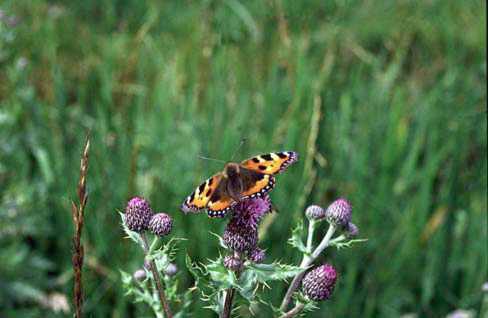|
What is biodiversity?
Biodiversity, short for ‘biological diversity’, is a relatively new word
that has been coined to express the richness of nature or variety of life.
It came into use after the UK government signed up to the Convention on
Biological Diversity at the Earth Summit in Rio de Janeiro in 1992.
Crucially, biodiversity is concerned with the relationship of nature and
people, and sees the natural world as a vital asset, essential to our
survival and quality of life. As a concept, it asks us to use our
resources in a sustainable manner, i.e. in a way that doesn’t compromise
our children’s abilities to use them too. “Biodiversity, our
planet’s most valuable resource, is on loan to us from our children.”
Biological diversity is also part of our cultural heritage - the current
distribution and numbers of plant and animal species is, for better or
worse, a result of human management. This biological richness is a
vital component in the future development of our county.
Agriculture, forestry, fishing and fish farming all relate to the natural
environment of Scotland, and it is also a major component of the tourism
industry.

Small Tortoiseshell
How is this being taken forward
nationally?
The UK Biodiversity Steering Group was created to help us meet the
commitment agreed at Rio, and in 1995 it published a Report containing
action plans to conserve 116 species and 14 habitats, together with
recommendations for future biodiversity action plans. Since then, a
further 6 volumes of habitat and species action plans have been published.
There are now 45 habitat action plans (HAPs) and 391 species action plans
(SAPs), which are being taken forward by government agencies and other
large organisations. Local authorities and others are being
encouraged to take local action to promote biodiversity, to complement
national action programmes and projects. Under the Highland
Biodiversity Project, a plan is being prepared for each area of Highland,
focusing on the areas of Caithness, Sutherland, Ross & Cromarty East,
Wester Ross, Skye & Lochalsh and Lochaber. Inverness & Nairn and Badenoch
& Strathspey are already covered by related initiatives.
|
Under the Highland Biodiversity
Project, a plan is being prepared for each area of Highland, focusing on
the areas of Caithness, Sutherland, Ross & Cromarty East, Wester Ross,
Skye & Lochalsh and Lochaber. Inverness & Nairn and Badenoch & Strathspey
are already covered by related initiatives.
What is this plan about?
This plan for Sutherland has been prepared by the Sutherland Biodiversity
Group, a group of local people representing a broad range of interests. It
sets out what can be done in the next five to ten years. The plan is
non-statutory, i.e. it is not legally binding. However, with increased
emphasis being placed on biodiversity and related issues by successive
governments, it is widely accepted that such plans will become
increasingly important in the targeting of resources and setting of
priorities. This plan is not about preservation of the status quo, nor
about attempting to turn back the clock thousands of years. We do not live
in a pristine wilderness nor could we ever return to such a state.
It is about:
-
Recognising the importance of
biodiversity to
our future prosperity and quality of life;
-
Ensuring that we adopt or continue
with
good practices that sustain and enhance our
biodiversity and amend practices that damage the environment Identifying
opportunities for enhancing our environment to protect our livelihoods and
-
Identifying opportunities for
enhancing our environment to protect our livelihoods and provide a good
inheritance for our children.
Many of the land management and
other practices discussed in the plan are governed, directly or
indirectly, by regulation, legislation and financial support from outwith
Sutherland - Inverness, Edinburgh, Westminster and Brussels. A key
part of this Biodiversity Action Plan is to identify local issues and
opportunities to feed back to the decision makers outwith the county. It
will also suggest future projects or amendments to wider policies that
reflect local needs and assist good practice.
|











